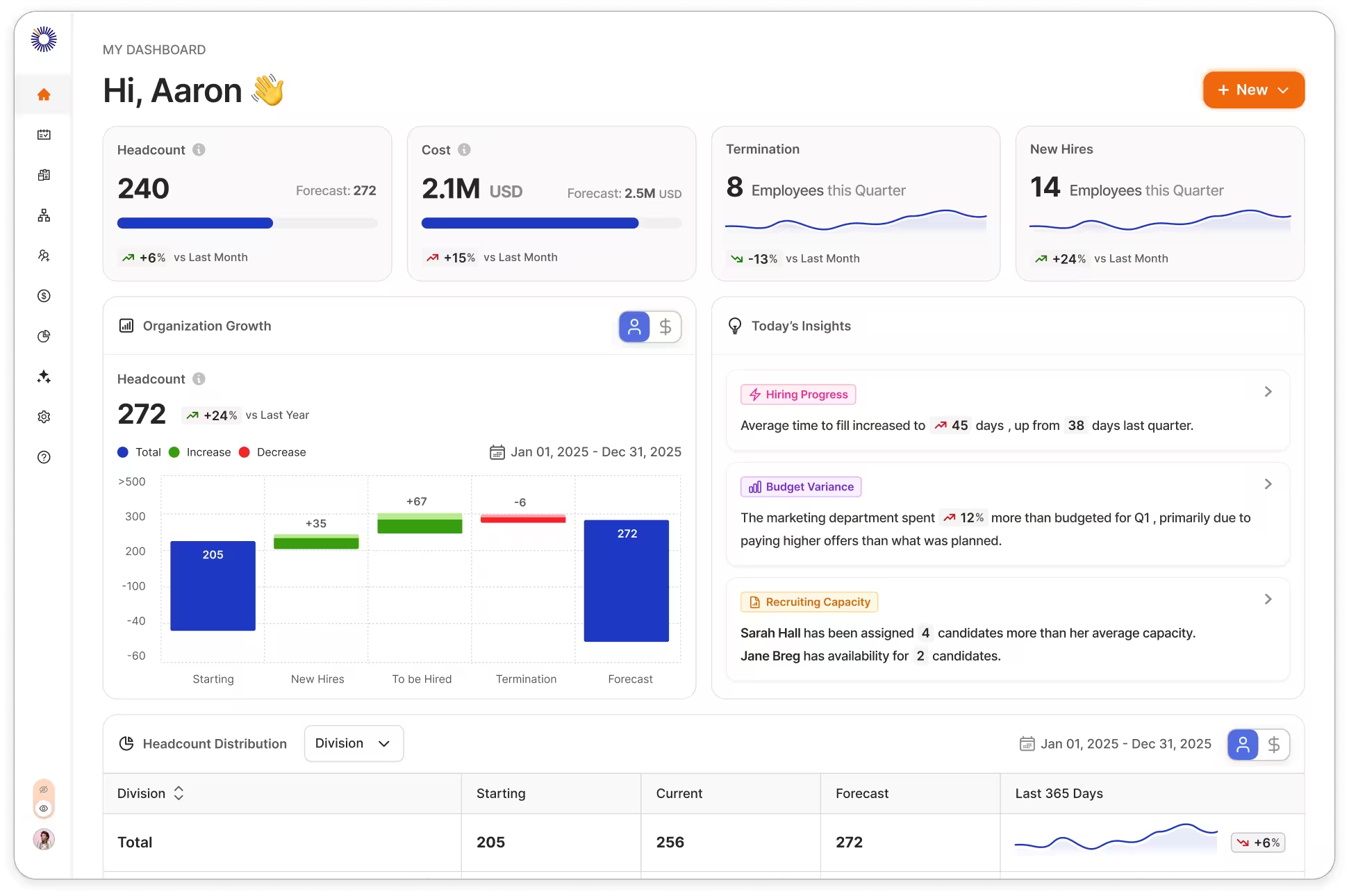Headcount management platform
Manage headcount with confidence.
Unify Finance, Talent, & HR in one AI-powered platform built for precision, speed, and alignment.


“I think TeamOhana is amazing... it solves a lot of the problems that we traditionally haven't been able to solve efficiently between both our FP&A tool as well as our HRIS. It's been able to bridge that gap and it's been really great.”
—Kenny Tran, Head of Business Transformation

A single operating system for all your headcount data.
Financial snapshot: Instantly view current and projected headcount costs, hiring trends, and budget impact.
Exec ready insights: Provide leadership with a clear picture of workforce costs and plans in real time.
.avif)
Build strategic, long-term plans with confidence.
Budget and forecasting: Track new hires, transfers, and departures and accurately manage headcount.
“What if” scenarios: Run dynamic hiring and budget scenarios based on market shifts to make proactive adjustments.
%202%20(1).avif)
Simplify hiring—from planning to onboarding.
Hiring tracker: Build seamless approval workflows and track hiring plan changes in real time.
Recruiter experience: Proactively plan capacity, efficiently assign roles, and avoid bottlenecks as hiring scales.
%202%20(1).avif)
Drive efficient compensation cycles and stay on budget.
Streamline workflows: Run transparent processes for promotions, bonuses, and merit increases.
Budget control: Centralize and manage compensation decisions with a single, controlled budget.
%20(1).avif)
Move the business forward through strategic headcount management.
Operate with agility: Drive continuous improvement by making well-informed decisions on the fly.
Org design: Visualize and design optimal team structures to ensure your strategy supports company goals.
%20(1).avif)
100+ one-click
integrations
Headcount management software purpose-built for collaboration
If you’re still using spreadsheets to manage headcount, you're flying blind. To succeed today, businesses need collaborative workforce intelligence.
TeamOhana was purpose-built to unite Finance, Talent, HR, People teams and Hiring Managers in one user-friendly platform where everyone can access real-time data pulled from your FP&A, HRIS, ATS, and other systems. TeamOhana brings real-time visibility, smarter collaboration, and automated workflows to every step of the headcount process.
With TeamOhana, you can:
- Plan and forecast with confidence. Align hiring plans to budget in seconds, not days. TeamOhana eliminates the manual overhead of reconciling headcount data across tools, giving you real-time forecasting and financial impact visibility with every change.
- Visualize your org today and tomorrow. Our dynamic org chart combines current and future roles in one unified view. Move open headcount, explore future org structures, and align your hiring plan directly in our drag and drop org chart.
- Run scenarios in minutes, not hours. Need to delay a hire? Change a comp band? Freeze hiring in G&A? TeamOhana lets you model the impact of every decision across teams and departments in a matter of minutes. And thanks to access controls and enterprise-grade security, anyone on your team can model scenarios with just the data they need.
- Collaborate across departments, seamlessly. Stop chasing approvals in email threads. With TeamOhana’s approval workflows and Slack integration, everyone from Hiring Managers to Leadership is looped in and notified when their input is required. Collaboration happens seamlessly and quickly with audit trails.
- Get the insights you need with AI-powered headcount analytics. Get the data you need to make strategic headcount decisions faster. TeamOhana integrates with FP&A, HRIS, ATS, and other systems so you can surface key insights based on aggregated data in real time. Or, ask your TeamOhana AI copilot open-ended questions like, “What is the total annualized cost for unapproved headcount requests?” or “Hiring for which headcount is at risk of being delayed?”
Headcount management software FAQs
TeamOhana is redefining how companies plan, manage, and optimize headcount. By connecting your ATS, HRIS, and FP&A systems, we bring Finance, HR, and Talent together in one platform—so teams can collaborate, model scenarios, and execute hiring plans without relying on spreadsheets.
Yes. TeamOhana is part headcount management software, part workforce planning software, and a whole lot more all rolled into one. We help teams involved in headcount and workforce management focus more on strategy, forecasting, and actually driving business results.
TeamOhana is an excellent fit for companies with 150 to 10,000+ employees that are scaling headcount or managing frequent changes in hiring plans.
Yes, TeamOhana has helped many businesses including unicorn companies like SeatGeek and Scale AI grow their workforce. In the words of Teddy Collins, EVP of Finance at SeatGeek, “There was a big unlock for us, a very high ROI of bringing on this platform that has infinite scalability.”
TeamOhana integrates with more than 100 popular FP&A, HRIS, ATS, payroll systems and more including Workday, Oracle, Greenhouse, Ashby, Lever, ADP, Anaplan, BambooHR, and many more.
We’re proud to say that our platform was designed to be extremely user-friendly and support seamless collaboration from Executives all the way to Hiring Managers and Recruiters. Tracie Akers, Chief People Officer at Metronet says, “[TeamOhana] makes everything super easy for us to even roll out to our hiring managers at any given time… you don’t have to have a lot of knowledge or expertise into a system, it’s just simple.”
Take control of your headcount spend



















.png)
